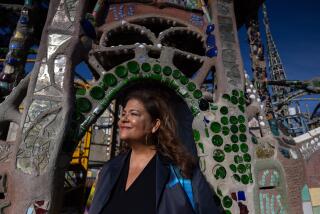G. Van der Kemp, 89; Led Restoration of Versailles
Gerald Van der Kemp, a French curator who raised millions to preserve and restore the 17th century palace of Versailles outside Paris after decades of neglect, has died. He was 89.
Van der Kemp died at American Hospital in Paris on Dec. 28. The cause of death was not disclosed.
Called by a French magazine “The Man Who Gave Us Back Versailles,” Van der Kemp focused nearly 30 years of his life on returning the palace and grounds to their former sumptuous glory, tracking down lost artwork and supervising repairs, replantings and restoration of priceless paintings.
He was legendary for his fund-raising skills and traveled regularly to the United States with his American-born wife, Florence, to cajole wealthy Americans into supporting Versailles’ renovation.
“He invented the act of fund-raising by really using only his social connections, which were enormous, on both sides of the Atlantic,” said J. Patrice Marandel, chief curator of European art at the Los Angeles County Museum of Art.
Van der Kemp also supervised the restoration of Claude Monet’s home in Giverny, a project that took four years and cost $2.5 million.
Born to a family of Dutch origin in Charenton-le-Pont outside Paris, he studied at the Ecole du Louvre and the Institute of Arts and Archaeology. In 1936, he became an assistant curator at the Louvre.
His background landed him an assignment during World War II to protect French masterpieces, including Leonardo da Vinci’s “Mona Lisa,” at a secret chateau in southwestern France. After Paris was liberated, he personally carried the Mona Lisa up the steps of the Louvre.
In 1945, he went to Versailles as a curator. He found a decrepit heap: Staircases were sagging, the rooms were empty, and rain poured through the roofs to the basements. Nothing had been spent on palace upkeep for 80 years.
“It was in terrible condition,” he recalled in an interview.
“We had to repair the structure before we could recover the art.”
The latter task became a global treasure hunt.
When the court at Versailles was disbanded during the French Revolution, the contents were moved to Paris, then sold at auction in 1792 and 1793 and scattered to museums and private collections all over the world.
Van der Kemp contacted other curators and scoured auction catalogs from around the world to see if they had something for his palace.
Edmond de Rothschild contributed Riesener commodes made for Marie-Antoinette, and Barbara Hutton gave a Savonnerie carpet so fine that the curator kept it rolled up when the public came to visit.
Some works could not be recovered for Versailles, including the Mona Lisa, Mantegna’s “Entombment” and Giorgione’s “Musicians.” Many furnishings could not be replicated in their original, costly materials.
In the Hall of Mirrors, for example, Van der Kemp talked a San Francisco donor into giving $18,000 for a chandelier to be made in the Louis XV style, but other fixtures for the famous room were reproduced using plastic.
Nonetheless, even as an approximation of grand siecle splendor, the results were considered a spectacular success.
Van der Kemp “may not have been the greatest expert on Versailles or the greatest scholar,” said Marandel. “He left the nitty-gritty of researching the archives, knowing what kind of silk should be woven, to the experts. He was simply raising an awful lot of money to do all these things. He was an enabler on a grand, grand scale.”
To court prospective donors and thank those already swayed by his charms, Van der Kemp held intimate soirees and lavish balls at the palace. His wife, a former Washington society columnist, applied her considerable skills as a hostess to each event and also managed the Versailles Foundation, which was set up to receive contributions. She lived with her husband in a 21-room wing of the palace originally occupied by one of Louis XIV’s ministers.
Van der Kemp--tall, with an aquiline nose and carefully arranged hair, who always wore a boutonniere and a splash of gold-- “identified himself totally with Louis XIV,” Marandel said.
More than $70 million has been spent on redoing Versailles. Much of the money Van der Kemp raised came from deep-pocketed Americans, such as cosmetics maven Estee Lauder, MCA founder Dr. Jules Stein, and various Rockefellers.
“I have a lot of friends in America who love French art,” he once said. “I never ask for money, but they see someone who has spent all his life restoring beauties and they give me money.”
If necessary, the curator appealed to their patriotism. “Versailles,” he would say, “was the cradle of your revolution and it is thanks to Louis XIV that you are free.”
Van der Kemp is survived by his wife, and a son, Frank.



